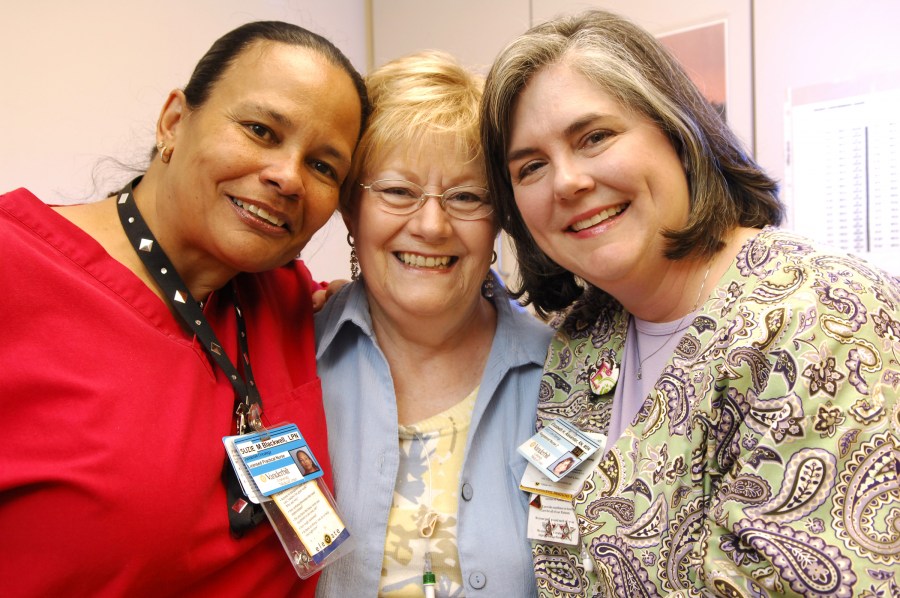
Emily Suiter, center, a patient at Vanderbilt-Ingram Cancer Center’s Oncology Clinic in Cool Springs, gives a hug to Suzie Blackwell, L.P.N., left, and Elizabeth Alexander, M.S.N., R.N. (photo by Anne Rayner)
VICC Oncology Clinic takes Magnet to heart
Vanderbilt-Ingram Cancer Center's Oncology Clinic in Cool Springs makes patient care its priority, and provides a strong example of why the Medical Center is deserving of a second Magnet designation.
Though the clinic is 16 miles from the main Vanderbilt University Medical Center campus, the culture of this suburban clinic embodies the VUMC Nursing philosophy of providing the highest quality care.

Every day the clinic's health care team manages up to 70 patient appointments for infusions, chemotherapy, lab work or other needs. The clinic staff works as a cohesive team.
They are dedicated to helping patients cope with their disease and make important transitions during their journey with cancer.
“Everyone, including our front desk staff, our patient services representatives, billing staff, our nurses and physicians, wants to make sure each patient is taken care of,” said Suzie Blackwell, L.P.N.
“We do that by paying attention to details and always trying to improve our patients' experience with us.”
Sometimes the improvements are a tweak here and there, such as changing the location of charts to synchronize them more closely with the flow of the patient visit. Other times, adjustments can be more comprehensive.
“We have an open communication system and get input from our colleagues as we strive to think of ways to do things better,” said Elizabeth Alexander, M.S.N., R.N.
For instance, the staff understands that patients with cancer typically spend a lot of time in various health provider waiting rooms, and many patients are on a regime of daily treatments for several weeks.
So, this clinic has launched several nurse-suggested initiatives to improve patient flow. They have examined every step of the patient experience, and made many adjustments to reduce patient wait times.
The nursing staff also noticed that patients coming in for infusions often showed some anxiety in the time between being called out of the waiting room to the time all the equipment is ready for their treatment. So, they revamped the infusion treatment patient flow system. As a result, waiting times have decreased, but most importantly, the patients seem more comfortable.
“We can profoundly impact someone's life,” said Alexander. “Our patients love us because we will take care of them, fight for them and always keep their best interests at heart.”
In another effort in the high-volume infusion area, the clinic developed and implemented a pre-treatment checklist, much like a pre-operation checklist, that shows correct calculations, lab information and other important information.
Since adopting this new method, patient safety has been significantly enhanced.
“The reason these ongoing enhancements are possible is teamwork and good communication among all clinic employees,” according to Blackwell.
“We work well as a team. We can ask for help from co-workers and we can depend on each other,” said Blackwell.
“This environment brings out the best in everyone here. Our patients benefit. Our staff is organized and detail-oriented. I also feel that, even with 32 years of nursing experience, I learn new things and have been able to excel at the highest level.”













